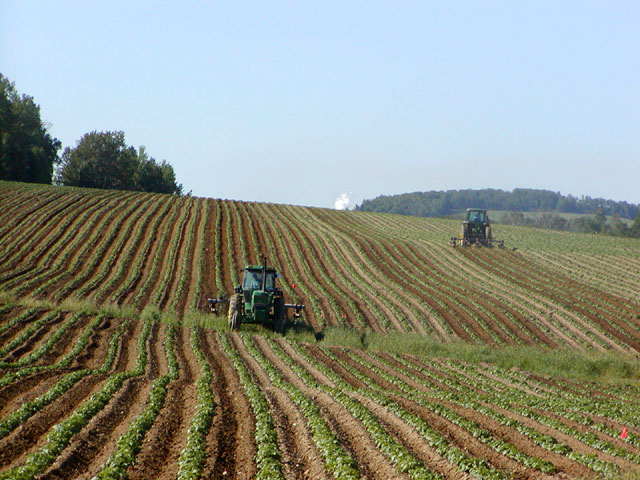
Monoculture
In agriculture, monoculture is the practice of growing one crop species in a field at a time.[1] Monoculture is widely used in intensive farming and in organic farming: both a 1,000-hectare cornfield and a 10-ha field of organic kale are monocultures. Monoculture of crops has allowed farmers to increase efficiency in planting, managing, and harvesting, mainly by facilitating the use of machinery in these operations, but monocultures can also increase the risk of diseases or pest outbreaks. This practice is particularly common in industrialized nations worldwide. Diversity can be added both in time, as with a crop rotation or sequence, or in space, with a polyculture or intercropping (see table below).
For the computing concept, see Monoculture (computer science). For the sociological concept, see Monoculturalism.
Continuous monoculture, or monocropping, where farmers raise the same species year after year, can lead to the quicker buildup and spread of pests and diseases in a susceptible crop.
The term "oligoculture" has been used to describe a crop rotation of just a few crops, as practiced in several regions of the world.[2]
The concept of monoculture can also extend to (for example) discussions of variety in urban landscapes.[3]
Forestry[edit]
In forestry, monoculture refers to the planting of one species of tree.[17] Monoculture plantings provide greater yields and more efficient harvesting than natural stands of trees. Single-species stands of trees are often the natural way trees grow, but the stands show a diversity in tree sizes, with dead trees mixed with mature and young trees. In forestry, monoculture stands that are planted and harvested as a unit provide limited resources for wildlife that depend on dead trees and openings since all the trees are the same size; they are most often harvested by clearcutting, which drastically alters the habitat. The mechanical harvesting of trees can compact soils, which can adversely affect understory growth.[18] single-species planting also causes trees to be more vulnerable when they are infected with a pathogen, attacked by insects,[19] or affected by adverse environmental conditions.[20]
Residential monoculture[edit]
Lawn monoculture in the United States was historically influenced by English gardens and manor-house landscapes, but its inception into the American landscape is fairly recent.[21] Aesthetics drove the evolution of the residential green areas, with turfgrass becoming a popular addition to many American homes. Turfgrass is a nonnative species and requires high levels of maintenance. However, the drive for its widespread use primarily came from social pressures. At the local level, governments and organizations have begun to take monocultural practices into their own hands (think Homeowner Associations). Various issues related to maintenance of private property have occurred, such as maintaining aesthetics and real estate value. Disagreements in residential maintenance of weeds, lawns, etc, have resulted in civil cases or even direct aggression against neighbors.[21]
Like agriculture, the high levels of maintenance required for turfgrass created a growing demand for chemical management, i.e. pesticides, herbicides, insecticides. A 1999 study showed that in a sample of urban streams, at least one type of pesticide was found in 99% of the streams. One major risk associated with pesticides on lawns include exposure of chemicals into the home through the air, clothing, and furniture which can be more detrimental to children than to the average adult.[21]
Monofunctionality[edit]
Monofunctionality is an analogous concept; however, it is entirely possible for a monofunctional land bloc to have its function produced by multiple species and so does not suffer from all the same downsides. When industrialisation first came to agriculture and silviculture, monofunctionality was advocated as the ideal due to the significant initial advantages in economic efficiency. However, in the years since opinion has shifted away. In the years since it has become clear that monofunctionality suffers from some of the same downsides as monoculture, specifically forgoing synergies and failing to fulfill the whole range of human needs.[27]